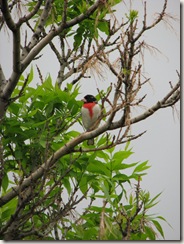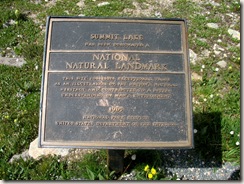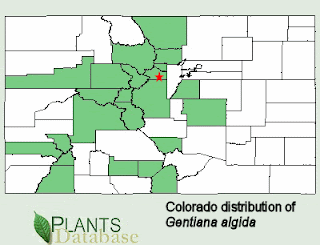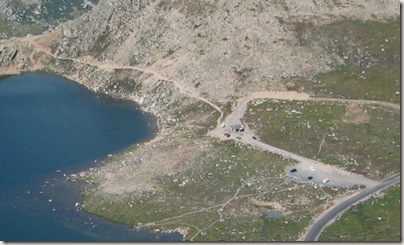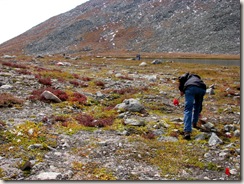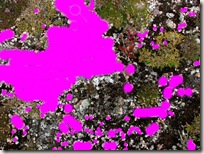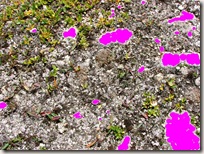We ventured forth to Bergen Park on a lethal quest, with murder in our hearts. I was to be introduced to a new weed for our area, one that was infringing on the edge of parkland. Clearly it had to go.

Happily for me, though,
Perennial Pepperweed (
Lepidium latifolium) was not the only plant we encountered that day. Here the pepperweed, which was not yet blooming, consorts with
Poison Hemlock (
Conium maculatum), another exotic, in full flower.

This post doesn't qualify for Plant of the Week; perhaps I should call it a "plant of last month." Late July and most of August were absorbed, it seems, in the wink of an eye! Forgive me for taking you back to early July for this little botanical adventure.
The first few plants we uprooted seemed innocuous enough, but I latched on to one, near the base of a small ponderosa pine, that soon delivered an extensive root system. Perhaps the mother of all pepperweeds...
According to
one reliable source,
"Perennial pepperweed is a highly invasive herbaceous perennial. It can invade a wide range of habitats including riparian areas, wetlands, marshes, and floodplains. It adapts readily to natural and disturbed wetlands. As it establishes and expands, the plants create large monospecific stands that displace native plants and animals."

So far so bad. The good news is that, in the course of an hour or so, the two of us seriously depredated this patch of pepperweed, leaving few, if any, survivors above ground to reproduce. The bad news is:
it's perennial. As we wandered the area, looking for any surviving remnants, we noticed an odd distribution pattern: it seemed to be associated with the pines. Here it also shows a bit of a zonation pattern, with hemlock behind, pepperweed next to the pine, and smooth brome in the foreground. Lovely.
Clearly we were not in a pristine ecosystem by any means. This is a park that is rapidly gentrifying, and has been used for almost a century. We were also right next to a "park and ride" for the local bus system. In beautifying the area around their new parking lot they had, logically, planted "native" ponderosa pines from a local nursery. (Though why they didn't use the many native pine seedlings on site, I can't explain.) We speculated that the source of the infestation was the root balls of these imported trees. Upon being informed of its presence, the bus company promptly mowed the entire area. Problem solved, right? Well, maybe...
The Park Service (source above) adds:
"Application of the control plan must be repeated numerous times to obtain lasting management.... Sources of infestations should also be located and eliminated to prevent future infestations.... Mechanical control options are typically not effective. Very small patches can be controlled by hand removal if the process is repeated often for several years and plants are not allowed to mature."
Looks like we have our work cut out for us. We have a chance, with conscientious monitoring at this site, to prevent this weed from gaining a foothold that will overwhelm our ability to deal with it in the future. It's early, here, for this one. Perhaps we won a battle, but vigilance, eternal vigilance, is the key in this war. Fortunately, some of our aggressive invaders are not so intractable.

Here's the meadow at Bergen, looking back into the park (a ponderosa pine grove). The brown seedheads of a Smooth Brome monoculture are distinct, enabling its immediate recognition. Most of us live, around here, in a world of mountain meadows dominated by
Smooth Brome (
Bromus inermis), which was deliberately introduced to the United States and Canada in 1880 from Hungary and in 1896 from Russia. It is still being actively recommended as a pasture grass.

As we moved away from ground zero of the pepperweed infestation, thankfully, more welcome denizens of a montane meadow began to assert themselves. To my surprise, there were harebells (
Campanula rotundifolia) still in bloom (long gone at my home elevation), blanket flowers (
Gaillardia aristata), and more. I might have gotten more photos, but the presence of a favorite mountain grass thoroughly distracted me.
 Parry Oatgrass
Parry Oatgrass,
Danthonia parryi, is not only elegant, graceful, beautiful, and
native, but distinctive and, thus, recognizable! (Always a desirable quality in grasses.) This year, with 3 more inches (7.6 cm) of rain than usual, I've been noticing it everywhere. I can only conclude I'd overlooked it before; I'd thought of it as somewhat rare, or at least unusual. I like it so much I once obliquely featured it in an article, and even put the illustration of it on my business card.

Here's what I didn't know about this intriguing grass: it is reported only from four states (MT, WY, CO, and NM) and two provinces (ALB and SASK). In other words, straight down the spine of the Rockies, primarily on the eastern side. It is secure in Alberta, according to
NatureServe, and imperilled in Wyoming; other areas have not been assessed. Within Colorado, its distribution is a bit irregular, most likely due to inadequate collections. Parry Oatgrass is, for example, not reported from our county, where this site (the red triangle) is.

Although they're surrounded by Parry Oatgrass, especially this year, I suspect that few mountain residents would recognize this grass under any circumstances. Here it shares the foreground with harebells and other wildflowers, as is proper, but smooth brome lurks in the background. Even long-time mountain residents think they see pristine landscapes where, in fact, they are seeing agriculture.
——
Perennial pepperweed, according to the
USDA Plants Database, has been introduced in about 20 states of the U.S. and six Canadian provinces. It is native to southeastern Europe and southwestern Asia and, according to the Park Service, "probably entered the U.S. prior to 1940 in a shipment of beet seed (
Beta vulgaris) from Europe." In Colorado it is a "List B" exotic weed. Smooth Brome, however, is still being planted.
——
Submitted for edition #20 of the plant carnival,
Berry-Go-Round.

 The invention of House of Herps was aided and abetted by Ted of Beetles in the Bush. Now that someone's taken up the herp challenge, Ted's inspired to do the same for his favorite insects, the beetles, at An Inordinate Fondness. That carnival will launch in February.
The invention of House of Herps was aided and abetted by Ted of Beetles in the Bush. Now that someone's taken up the herp challenge, Ted's inspired to do the same for his favorite insects, the beetles, at An Inordinate Fondness. That carnival will launch in February.












